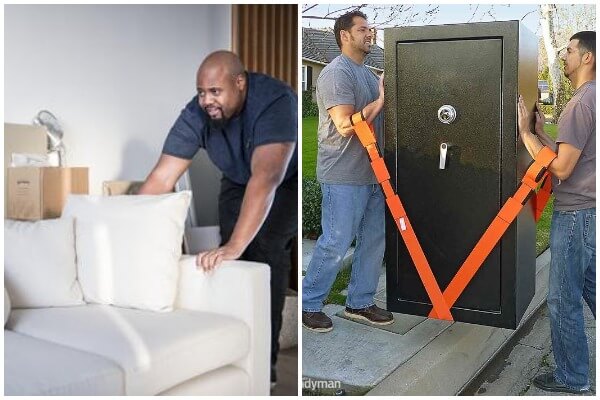Moving to a new home abroad is an exhilarating adventure that opens the doors to new experiences, cultures, and opportunities. However, amidst the excitement, it’s crucial not to overlook the safety of your cherished possessions, particularly your furniture. Ensuring that your furniture arrives at your new destination intact requires careful planning, meticulous packing, and strategic handling.
In this guide, we will delve into essential strategies to assure the safety of your furniture during an international move, guaranteeing that your treasured pieces remain unscathed and continue to adorn your new abode with elegance and comfort.

Packing with Precision: Safeguarding Your Furniture
As you prepare for your international move, the first step in ensuring your furniture’s safety is to adopt a packing strategy that prioritizes protection. Begin by disassembling larger furniture items, such as bed frames, tables, and shelves. Label each component to streamline reassembly at your destination. Fragile pieces, like glass-top tables or mirrors, necessitate extra care.
Wrap these in sturdy bubble wrap or specialized furniture blankets and secure them with packing tape. For wooden furniture, applying a layer of furniture polish before packing can act as a protective barrier against scratches and moisture.
When packing, consider the unique shape and dimensions of each piece. Utilize custom crates for intricate or unusually shaped furniture to prevent any unnecessary strain on the items during transit. Soft items, such as cushions or fabric upholstery, should be vacuum-sealed to minimize space while ensuring cleanliness. Don’t forget to remove any detachable parts, such as knobs or legs, and store them in clearly labeled plastic bags.
Choosing the Right Moving Company: A Prudent Investment
Selecting a reputable international moving company is a pivotal decision that significantly impacts the safety of your furniture during the move. Thoroughly research potential moving companies, paying close attention to their track record, customer reviews, and certifications. A reliable moving company will offer comprehensive insurance coverage, assuring you that your furniture is protected in the event of unforeseen incidents.
Engage in open communication with your chosen moving company. Provide them with detailed information about the type and quantity of furniture you’ll be transporting. This enables them to allocate the appropriate packing materials and equipment, such as specialized crates or climate-controlled containers for sensitive items.
A dependable moving company will also offer guidance on customs regulations and ensure all necessary documentation is in order, minimizing the risk of delays or complications.
Securing a Smooth Transition: Proper Handling and Unloading
Upon arrival at your new home abroad, the final leg of your furniture’s journey requires careful handling and unloading. Work closely with the moving crew, ensuring they adhere to the labeled instructions for each furniture item. Delicate items should be unpacked and reassembled with precision, while heavier pieces must be maneuvered safely to prevent damage to both the furniture and your new home’s interior.
When shipping goods to Australia from the UK, or any other place across the ocean, it’s important to inspect each piece of furniture as it is unloaded. Document any visible signs of damage, and promptly notify the moving company to initiate a claims process if necessary. Taking photographs of your furniture before and after the move provides valuable evidence in case of disputes.
Maintaining Climate Control: Preserving Furniture in Varied Environments
One often overlooked aspect of international moves is the varying climate conditions your furniture might encounter. Different regions can subject your furniture to extreme temperatures, humidity levels, or even sudden weather changes. To ensure the longevity of your pieces, it’s essential to consider climate control during the moving process.
Before packing, research the climate of your new location and assess whether certain items, like wood or leather furniture, require special treatment. Use moisture-absorbent materials or desiccants to prevent mold or mildew growth during transit. For delicate electronics or artwork, invest in climate-controlled containers that regulate temperature and humidity, shielding your valuables from potential damage.
Customs Compliance: Navigating International Regulations
The intricate web of customs regulations and import requirements can be a big challenge when moving furniture abroad. Each country has its own set of rules governing the importation of goods, which may include limitations on specific materials or hefty tariffs. To ensure a smooth transition, it’s imperative to research and comply with the customs regulations of your new country.
Begin by compiling a detailed inventory of your furniture, specifying materials, dimensions, and estimated values. Some countries may require additional documentation, such as permits or certificates of origin. Partnering with a knowledgeable customs broker can alleviate the complexities of this process, as they possess expertise in navigating international trade regulations and can help expedite clearance procedures.
Personalization and Arrangement: Transforming a New Space
Upon successfully transporting your furniture to your new home abroad, the exhilarating task of arranging and personalizing your living space awaits. Embrace this opportunity to reimagine your interior design while preserving the charm of your cherished pieces. Begin by envisioning the layout that best complements your new space and lifestyle.
Consider the natural lighting and flow of your new home when arranging furniture. Incorporate your pieces in a way that highlights their unique features and functionality. Be open to experimenting with different arrangements until you find the perfect balance of aesthetics and practicality. Integrate local design elements and artwork to infuse a touch of your new surroundings into your living space, creating a harmonious fusion of cultures that truly feels like home.
Embarking on an international move is an exciting endeavor, and ensuring the safety of your furniture is an essential aspect of this process. By addressing climate concerns, navigating customs regulations, and embracing the creative process of arranging your furniture, you can seamlessly transition your beloved pieces to your new home abroad. With careful planning and attention to detail, your furniture will not only survive the journey but will thrive in its new international setting, becoming an integral part of your vibrant global lifestyle.